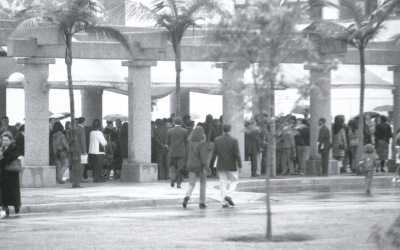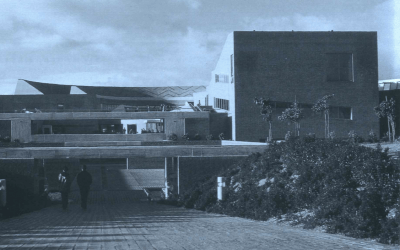Agrarian Reform in Colombia
The Role of Civil Society
It was a typical July day in the Colombian coastal tropics: sweltering heat, glaring sun, and severe humidity. Even in the shade of the big mango tree where I was sitting, my back was moist and sweat trickled down my forehead. Around me the voices of one hundred indignant peasants argued back and forth. They were usuarios, members or literally ‘users’ of the irrigation district, and they were congregated for the third General Assembly meeting of the summer. The Board of Directors that they had elected two years ago had been mismanaging the district, and the peasants were determined to depose it and name a new one. As they awkwardly advanced through the formal procedural steps, I took the first notes for my thesis.
The next six weeks of research were to be intense, and this meeting was very representative: heat, unpunctuality, disorderliness and the painstakingly inefficient formalities of bureaucracy. Ahead of me were two to four daily interviews and a significant amount of data collection in chaotic government offices.
This was the summer of 2002, in which I traveled to the northern coast of Colombia to research three irrigation districts built by the government as part of the agrarian reform efforts of the 1960s. In them was a puzzle that had always intrigued me, and my thesis was my excuse to explore it. Though the three districts—La Doctrina, Montería-Cerete and María La Baja—were similar on an infinite number of levels, their administrative performance differed immensely. While one provided itsusuarios with comparatively satisfactory service, the other two were marred in corruption and choked by debt. Through my six weeks of research and the 60 interviews I conducted, my plan was to find out why.
I had a suspicion as to the cause of such a noticeable difference—the ability of the peasants of each district to work together. It was their civil society, defined by Oxhorn as a “rich social fabric formed by a multiplicity of territorially and functionally based units,” that really differentiated the districts. While in the relatively successful district, the organization and mobilization of peasants towards a common goal was done easily and expertly, in the other two this seemed to be a nearly impossible feat.
That was to be my hypothesis: the civil society within each district was determinative of its administrative performance. This statement engulfed my attention for the remaining weeks of the summer, and my objective was to evaluate its accuracy and explain how such a strong civil society had come to be.
Most of the information I gathered was collected through interviewing each district’s peasants. I had hoped for a decent amount of numbers and hard data as well, but records keep very poorly in the tropics and termites are the enemies of history. I looked for information on the social movements of the region in the 1960s when the districts began, but the few documents I found were so brittle, yellowed and termite-ridden that reading them was impossible.
The hours of formal and informal interviews, therefore, were not only incredibly enriching but they also became my most consistent and reliable source of information. The questions I asked during those interviews were geared towards two issues: the government’s institutional influence and support since the construction of the irrigation districts and the trajectory of organization and collective action henceforth among the peasants.
By the end of the six weeks, I had gathered substantive evidence to support my hypothesis. I discovered that in the irrigation district with the best administrative performance and the most civil society, the peasants had repeatedly invaded the property of the area’s largest landowners until the government agreed to buy that land and turn it over to the peasants. The organizational effort that went into so many of those invasions was monumental, and the peasants quickly learned to mobilize and work together.
I discovered that, in one of the two districts with poor administrative performance, there had once been a strong peasant social movement shortly after the government built the district. When I inquired as to its legacy, my interviewees were silent. Without exception they asked me to stop my tape recorder and put my pencil down. The region was the paramilitary’s stronghold and the answer to my question was a delicate issue. I soon found out the paramilitaries had decimated the leftist-leaning peasant leaders during the 1980s, and since then no peasant dared organize for fear of them.
The third irrigation district, also of poor administrative performance, confirmed my hypothesis. In its forty-year history, it never had a substantive amount of civil society, and today its peasants were running into serious organizational difficulties with its administration.
My thesis research helped me understand the importance of civil society and the empowerment of the commons. When the peasants in two of the irrigation districts realized the strength of their numbers and the power they could garner by organizing towards a shared purpose, the likelihood of their administrative performance increased ten-fold. For the third district whose peasants failed to come to such a realization, their path led to doom. In effect, today only the district that had a strong civil society and did not endure a decade of paramilitary killings succeeds today. For me, such evidence was very telling, and by the end of my six weeks on the Colombian coast, I knew I had found an important story.
Beyond my actual research, there were myriad unforgettable moments during my interviews, many more important to me than the actual thesis research. The peasants’ generosity struck me: I left most interviews with bulging sacks of guavas, mangos or corn, and while I was in their homes, tinto (black coffee) would flow from the kitchen. Considering their meager levels of income, I was stunned.
Other gratifying interviewing experiences were those on the land that had once belonged to my family. During the agrarian reform of the 1960s, my grandparents were forced to sell much of their land for worthless government bonds and I was able to interview the peasants that now lived on it. Though my feelings towards the usefulness and success of the agrarian reform are still are mixed, it was comforting to know the land was inhabited and well-used. In addition, many peasants remembered my grandparents fondly and plunged into myriad stories about them.
Perhaps the most disturbing information that I learned from my interviews was the male-oriented character of the agrarian reform and the extent to which it had reinforced the strong macho culture of the region. The government distributed land to the head of the family—who was usually male—and henceforth all of the loans and programs that they sponsored were geared towards that individual. This resulted in the men of the region obtaining most of the government’s aid while their wives only could hope that some financial support would trickle down to them and their children. Within five years, brothels sprung up next to every district and the peasants themselves openly told me that they kept three or more women in addition to their wife. Only recently has the government realized their colossal mistake, and it is only lately that they have actually tried to take women into account.
Such is a glimpse into my summer experience and the things I learned. I returned to Harvard with a story and a hypothesis I could prove, but more importantly, I came back with a better understanding of the peasants of the Colombian coast, of their life and of myself.
María Paulina Mogollón is a Colombian Pforzheimer House resident. She will graduate in June with a Latin American Certificate, a French Citation and Honors from the Government Department.
Related Articles
On the Verge of Combustion
An exceptional narrative renewal is taking place in Colombia. And yet, there is neither a dazzling figure who has captured the hearts of million of readers in the continent, as Jorge Isaac, José Eustasio…
Colombian Immigration
A walk along Roosevelt Avenue in Jackson Heights, Queens, reveals the world of Little Colombia: neighborhood streets lined with small bakeries; the smell of fresh bread and arepas blend with the sounds of cumbia, the national musical style.
Bogotá Libraries
Last year, 9-year-old Jonathan Huertas and his three younger siblings spent their vacation indoors watching television—their mother was too afraid to let them play in the streets …




